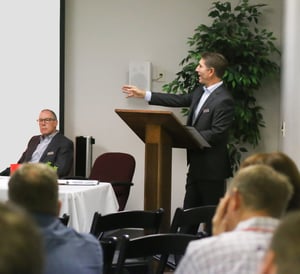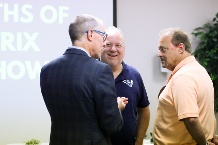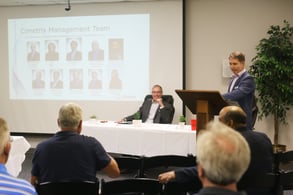
Over the past six months, Cimetrix has hired some fantastic new employees in a number of positions, including software engineering, quality assurance, client training and support, and even some new administrative positions. As we are always searching for good employees, there are times I reflect on my father’s legacy of over 30 years with NASA and think of all the challenges NASA faced finding good people in their quest to put a man on the moon. I remember him talking about the “young kids” coming into the organization. By the way, those “young kids” are now my age and older, including many that are retired. Today I find myself using the same term, “young kids” and, as I do, I catch myself and laugh.
Finding “The Right Stuff,” if you will excuse my cheesy reference to the movie version of the Mercury 7 first manned space flights in the early 60’s, is no easy task—especially in these days of low unemployment for highly skilled technical people. But we have found if you make the investment in your recruiting process, you can attract smart talent and greatly increase your chances of finding superior employees that enjoy high job satisfaction, fit well with the team, and contribute to the success of the organization.
To make a successful hire, we move slowly and take our time getting to know the candidate. Our philosophy is that everyone has natural strengths and talents. A good fit is when a potential new hire can leverage their natural strengths and talents in the job function and matches the core values of the company. The right job for anyone is the job that provides an outstanding opportunity to apply those natural strengths and talents in teamwork with others towards a compelling vision and opportunity. You must find someone who possesses the skills your company is looking for, shares the same core values as the company, and is priced at a range that is equitable in the organization. If there is misalignment in any of these core characteristics, DO NOT HIRE.
A good recruiting process takes patience but, with patience, comes risk. If an employer take too long in the recruiting process, they risk losing a good candidate to other offers. On the other hand, if a company possesses the clout of, say, Google, patience becomes the burden of the candidate and not the hiring company. According to Laszlo Bock, author of Insights from Inside Google, ‘Work Rules’ that will transform how you live and lead, Google may take six months to make an offer. I suspect in the early 60’s, NASA carried the same clout as Google because almost everyone in America wanted to be part of creating history.
Bottom line, recruiting is an investment in a long term relationship. Be thorough. Involve a large number of employees across the organization in the hiring and decision making process. The initial interaction on how a candidate treats the receptionist can be very revealing. Administer “talent tests” to validate required skills. Call references. Perform the necessary educational and other background checks. Take the candidate to lunch in a more social environment and observe how they interact with others. Leave no stone unturned. If you are diligent in the recruiting process, you may just find “The Right Stuff” for your organization.
For more insight into successful hiring, read How to Think About Hiring: Play Smarter to Win the Talent Management Game by Lex Sisney, CEO Coach and author of Organizational Physics.♦
 Cimetrix held its annual shareholder meeting this past Friday, August 16, 2019 at our headquarters in Salt Lake City, UT. It was nice to see many familiar faces as well as some new faces. There was just one proposal voted on at the meeting to re-elect all five Directors, which was approved by shareholders with over 99% of the votes cast in favor of the proposal. Bob Reback, our President and CEO, introduced each member of Board of Directors and provided a brief history of each board member’s tenure with Cimetrix and the specific expertise and value each of them bring to Cimetrix and our shareholders. We appreciate the wisdom, hard work and direction from our talented board members as well as their commitment to fairly represent the interests of shareholders. We are thankful to our shareholders for their continued support of Management and our Board of Directors.
Cimetrix held its annual shareholder meeting this past Friday, August 16, 2019 at our headquarters in Salt Lake City, UT. It was nice to see many familiar faces as well as some new faces. There was just one proposal voted on at the meeting to re-elect all five Directors, which was approved by shareholders with over 99% of the votes cast in favor of the proposal. Bob Reback, our President and CEO, introduced each member of Board of Directors and provided a brief history of each board member’s tenure with Cimetrix and the specific expertise and value each of them bring to Cimetrix and our shareholders. We appreciate the wisdom, hard work and direction from our talented board members as well as their commitment to fairly represent the interests of shareholders. We are thankful to our shareholders for their continued support of Management and our Board of Directors.






 With unemployment rates at some of the lowest rates in 10 years, keeping good employees can be a challenge. Ownership in the company they work for is one benefit highly valued by many employees. We all want to be part of a growing business, make it successful, and know we will be rewarded for our hard work. Cimetrix wants to provide such ownership incentives to our employees and do it in such a way that is fair and motivating to the employees while being fiscally responsible to shareholders.
With unemployment rates at some of the lowest rates in 10 years, keeping good employees can be a challenge. Ownership in the company they work for is one benefit highly valued by many employees. We all want to be part of a growing business, make it successful, and know we will be rewarded for our hard work. Cimetrix wants to provide such ownership incentives to our employees and do it in such a way that is fair and motivating to the employees while being fiscally responsible to shareholders.
